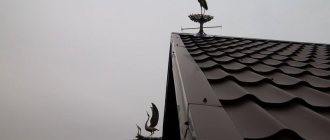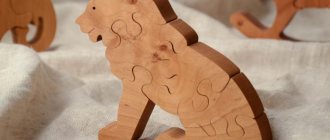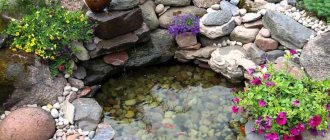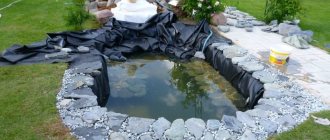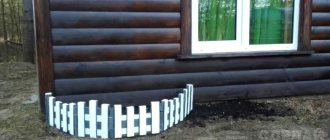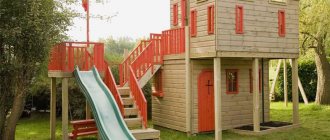There are many objects of different sizes and shapes, with the help of which property owners strive to decorate it, distinguish it from the surrounding buildings, and give it an interesting and original look. One of the options for such decorations are weather vanes. Despite the abundance of modern solutions, this detail of the external interior remains relevant to this day. In addition to decorative ones, it performs practical functions. Making a weather vane with your own hands is not difficult, but to do this you need to decide on its structure, role and purpose.
Story
The weather vane has its own rich history. There is no exact information about who and when the first weather vane was made. But today it is known for certain that the first weather vane decorated the Tower of the Winds in Athens, and this was around 48 BC. This weather vane was an image of the sea god Triton and the direction of the eight winds. You can immediately understand that even the very first design had a symbolic meaning.
The tradition of making weather vanes in the shape of a rooster originated in England. There, since ancient times, it was considered a symbol of a new day, vigilance and had magical meaning. The rooster is also a symbol of Christianity. During his reign, the Pope ordered all churches to be decorated with the image of a rooster, which symbolized the Apostle Peter. Thus, the roofs of cathedrals in Catholic Europe began to be decorated with weather vanes depicting this bird.
The rooster is also a symbol of France, which is why its people love to decorate their houses with weathervanes with this particular image.
The Vikings also loved this device. They made weather vanes from bronze, often gilded, depicting figures and scenes from Scandinavian mythology. The Vikings often placed their weather vanes on their ships. The symbol of the stork - the patron saint of the family hearth - originated in the Scandinavian countries.
During the era of feudalism in Europe, the weather vane was made with the image of the coat of arms of the owner of a particular castle. The Japanese and Chinese, who had their own mythology, loved to decorate their homes with weathervanes depicting a dragon. He brought good luck to the house and protected it from evil spirits.
In Rus', weather vanes began to appear in the 15th century as home decorations. Initially they were made in the form of a flag. But over time, they began to depict animals, people and mystical creatures.
In 1782, by order of Empress Catherine II, the largest weather vane in the world was made and installed. The name he was given is symbolic - Tsar Weathervane. But, unfortunately, due to its enormous weight, it did not last long and was subsequently melted down.
Over time, this device gained increasing popularity, so in Europe, at the end of the 17th and beginning of the 18th centuries, workshops even began to appear in which weather vanes were produced en masse.
It should be noted that this trend is still observed today due to the growing demand for this design. As it turned out, weather vanes have not lost their meteorological value. Forecasts do not always correspond to reality, and modern weather vanes, equipped with a more complex design and electronic filling, can easily determine the strength of the wind and its direction.
They are most often used by modern weather services and aviation bases.
Today, the simplest version of this device has lost its scientific value due to the development of technology, but modern people still decorate the roofs of their houses with this simple device for decorative purposes.
The purpose and principle of operation of the weather vane
Many owners of private houses are thinking about how to make a weather vane with their own hands at home with a minimum of effort, money and time. However, before you start making it, it would be a good idea to learn about its purpose, structure, varieties and meaning of symbolism. Let's look at them in more detail.
A weather vane is a decorative element of the roof of a house and a multifunctional device. The principle of its operation is based on the interaction of a special part - a flag - with the air flow.
The force of the wind turns it in the direction of minimal resistance. In this case, the counterweight arrow will always show the direction from which the wind is blowing. If you have a light propeller, the device will also determine the wind load, and when connected to other devices, it will also perform other useful functions.
Depending on the tasks assigned to it, it can have one or several of the following purposes:
- Decorative.
- It is part of the exterior design of the building.
- Meteorological.
- Acts as a device showing the strength and direction of the wind, as well as its quantitative measurement when a meter is connected.
- Protective (for chimney).
- Closes the pipe outlet from precipitation, objects and wind.
- Electricity generating.
With sufficient power of the blades and constant high wind force, it is possible to connect a generator to generate electric current.
In addition, a weather vane can protect both the house itself and the surrounding area from rodents. However, in this case it is not installed on the roof, but directly on the site.
Interesting information! A weather vane is one of the obligatory elements that crown the roof of a private house in almost all European countries. Moreover, in each specific case it looks original, unique for the entire area.
Briefly about the main thing
The weather vane interacts with the air flow and shows its direction. When connected to a sensor, it is also capable of measuring its speed. Depending on the purpose and design, there are the following varieties:
- Decorative.
- Meteorological.
- Protective for chimney pipes.
- Generating electric current.
- Repels rodents and birds.
In the standard version, it includes a flag, a boom, a counterweight, a vertical axis with a block and fastening elements, a propeller and a protective cap. Its main most noticeable part - the weather vane - can be made in the form of various figures - a rooster, a cat, a lion, a horse, etc.
As a rule, wood, steel, copper, plastic and plywood are used as manufacturing materials. They all have characteristic pros and cons. When installing a weather vane, it is necessary to observe its orientation vertically and to parts of the world - in the presence of a wind rose. An elementary model can be made quite easily according to the instructions, but more complex and high-quality options are available only to professionals.
Device
Basic elements of a weather vane:
Checkbox.
This is the main part of the device. Under the influence of the wind, its plane turns around and stands parallel to the air flow. It is made in any geometric shape or with artistic design - a thematic figure. Thanks to this, it gives the main decorative value to the entire device.
Arrow.
Placed on the opposite side of the flag. The main purpose is to indicate the direction from which the wind is blowing. It is not a mandatory design element - if the flag is installed directly on the vertical axis.
Counterweight.
Installed on the opposite side of the flag axis. Balances the flag-boom system (wind vane). As a rule, it has the same mass as the opposite part. Sometimes it is more difficult when the device is made so that when there is no wind it returns to the same position.
Vertical axis with housing and mounting block.
The axis on which the weather vane is located is fixed in a special housing and sits on a bearing. In an effort to simplify the design, it is often simply installed in a pipe of a suitable diameter. At the bottom, to facilitate rotation, it simply rests on a metal ball.
Protective cap.
It is placed directly above the vertical axis and serves as protection against the penetration of moisture and dust into the rotating mechanism.
Propeller.
Mounted instead of a boom and allows you to estimate wind speed. Electronic meteorological meters or an electric generator can be connected to it.
Fastening elements.
Depending on the material and design of the roof, brackets, screws, bolts and other fasteners are selected in each specific case.
Advice! When choosing how to make a weather vane with your own hands, you need to take into account the smallest details, so as not to carry out complex modifications later. One of these elements is the wind rose. It consists of a pair of rods crossed at right angles, on the edge of each of which a letter with the corresponding part of the world is installed. After it is correctly aligned with the compass, you can quite accurately determine the direction of the wind.
Briefly about the main thing
The weather vane interacts with the air flow and shows its direction. When connected to a sensor, it is also capable of measuring its speed. Depending on the purpose and design, there are the following varieties:
- Decorative.
- Meteorological.
- Protective for chimney pipes.
- Generating electric current.
- Repels rodents and birds.
In the standard version, it includes a flag, a boom, a counterweight, a vertical axis with a block and fastening elements, a propeller and a protective cap. Its main most noticeable part - the weather vane - can be made in the form of various figures - a rooster, a cat, a lion, a horse, etc.
As a rule, wood, steel, copper, plastic and plywood are used as manufacturing materials. They all have characteristic pros and cons. When installing a weather vane, it is necessary to observe its orientation vertically and to parts of the world - in the presence of a wind rose. An elementary model can be made quite easily according to the instructions, but more complex and high-quality options are available only to professionals.
Select an option
Undoubtedly, a beautiful and original weather vane can be purchased in a store. But it is also possible to make it yourself at home. To do this, you need to select the appropriate material and develop a detailed sketch of the device.
The weather vane can be made from a variety of materials:
- plywood;
- tree;
- metal;
- plastic or plastic bottles;
- old CDs.
The last two options are suitable for small structures that can be placed, for example, on the roof of a veranda or gazebo. Plywood and wood are short-lived materials, even if they are treated with special means.
Metal can withstand all weather changes and strong gusts of wind, so it is considered the most successful material for a decorative weather vane.
The most important step is choosing a figure for the flag. After all, there are opinions that this is not just a decorative element, but also a kind of symbol. Therefore, any image has its own mystical overtones.
The symbols are deciphered as follows:
- The rooster is very popular in Russia; it scares away evil spirits.
- The cat is a symbol of home comfort.
- The owl symbolizes wisdom.
- Leo , the king of beasts, indicates power and strength.
- The eagle helps protect your home from enemies.
- The stork brings mutual understanding and happiness to the house.
- The goose is a symbol of vigilance, love and order in the home.
- The chimney sweep is a symbol of good luck.
- George the Victorious protects the house from any troubles.
- Baba Yaga opposes the evil influence of evil spirits.
When choosing a weather vane figurine for your home or cottage, it is better to familiarize yourself with what it can symbolize.
It should be noted that there are several main functions that this design has.
- Meteorological. First of all, a weather vane serves to measure the speed and strength of the wind and indicate its direction.
- Protective. When installing this structure on a chimney, it serves as protection from strong wind blowing.
- Repellent. If you install a propeller on the weather vane and place this device not on the roof, but on the ground, then the vibrations will repel moles, rodents and shrews. If you install an electronic windmill, the effect will be stronger.
- Decorative. This device often has a very attractive appearance, so it is installed on the roof as an unusual decorative element.
Types of meteorological structures
All weather vanes are conventionally divided according to their purpose (not counting decorative). So, the types of weather vane can be:
Meteorological. Experts often call them anemorummeters. This tricky name is directly related to their use by meteorologists. Such a system is equipped with special sensors that transmit data to a computer.
Wild weather vane. In addition to the direction of the wind, they can also measure its strength thanks to the built-in plate.
Chimney weather vane. An additional function is to prevent backdraft in the chimney and the penetration of precipitation, dust, and other things. An alternative would be to cover it with a chimney.
Making a weather vane with your own hands is not a difficult task, but it is very necessary.
Once you install such a structure at home, it will be difficult to imagine that once upon a time everything was different. Having ventured into such an undertaking, you will need patience and all the necessary materials and tools.
Materials and tools
Typically, the design of a simple weather vane includes the following elements:
- A flag that turns in the direction of the wind. It can have a simple geometric shape or an unusual decorative design and be the main decoration of the device.
- Arrow. The figurine is most often placed on it.
- Counterweight. It is located on the opposite side of the flag. It must have a greater mass than the mass of the flag, then it can return to its original position.
- Vertical axis. It is mounted either on a bearing or on a metal ball, which allows the structure to rotate.
- The cap prevents water from entering the bearing.
It is best to make a flag from metal, for example, it can be copper or steel. This way it will be much more durable than a product made from wood or plywood sheets.
There is always the opportunity to make a forged product, but it will be quite heavy, and not everyone can do it on their own. And the work of a master will be expensive.
Any material must be treated with a protective coating, such as paint, to withstand the elements.
The base and axle should be metal, as this is a very strong material for their construction.
To make a weather vane with your own hands, you will need special tools:
- a jigsaw for wood or metal (this is useful for cutting out a flag);
- drill;
- hammer;
- soldering iron;
- vice;
- pliers;
- grinder and files;
- sandpaper.
Quality factor of the metal structure
It will be quite difficult for beginners to start making a weather vane for a metal house. If difficulties do not frighten you, then you need to prepare a stencil of the future image or a sketch if the work will be done from scratch.
For these purposes, it is most convenient to use cardboard, since it will then be easier to transfer it to a metal plate.
You will also need a model of the turning part and arrows; they will be the ones that will show the direction of the wind in the future.
The drawing must include everything down to the smallest detail, from the arrow parameters to the rotation unit.
Drawing
First of all, you need to decide which figure will crown the weather vane. Then you need to create its drawing with your own hands. If you have never cut out this kind of shapes before, then it is better to stick to a simple option for better execution.
The circuit is very easy to make yourself. It is better to first draw a drawing on a regular sheet of paper, and then complete it in exactly the size that the figure will be, thereby obtaining a stencil. This stencil will be universal for any manufacturing material. It is better to choose its dimensions in the range from 300 to 500 mm, otherwise the flag may break.
Manufacturing stages
Regardless of the choice of materials and shape of the figurine, the manufacturing steps will be the same.
- The main parts of the structure are the axle and its body. The process of rotating the weather vane will depend on them. It is better to install the axle on a bearing, and the diameter of its base should clearly match the diameter of the bearing. The bearing must be covered with a housing to prevent moisture from getting on it.
- During the manufacture of the device, it is very important to follow all the technology, since its functioning will directly depend on this.
- Figures cut out from a stencil using a plasma cutter or sawed out with a jigsaw are very beautiful. An updated version of the fan type can be made from an old weather vane. It will look more modern.
- The first step is to make a flag. A pre-prepared stencil is placed on a sheet of metal, secured with clamps and cut out using a jigsaw. Cutting out a design with a regular hand jigsaw is a very complex process. Therefore, if you have a jigsaw, then it is better to use it. If you prefer metal, for example, plywood or a plastic panel, then you can use a plasma cutter.
- As soon as one part of the figure is cut out, you need to loosen the fastening and turn the sheet over so that you have free access to the other part. The lines must be cut carefully so that no irregularities arise. It is better to carry out all work on a metal table.
- After the figure is cut out, it needs to be sanded well using a sanding machine. Small holes are cut using a drill and smoothed with a file.
- After making the flag, you need to make an arrow. It is also better to make it from metal. A stencil is applied to it and the required shape of the product is cut out. The boom will include two parts, which are manufactured separately. Both parts need to be sanded well.
- Both parts of the pipe are welded to the turning mechanism. A metal ball or bearing can be used as it.
- After the arrow is secured, you can attach the figurine prepared earlier. It is also better to do this by welding for greater structural reliability. The flag must be secured to one part of the arrow, since there will be a counterweight on the other at its sharp end.
Support
To make the support you will need a thick metal rod. It is attached to the end of a pipe, into which a metal ball must also be placed.
Lid
The cover can be made of any materials, the main thing is that it fully matches the dimensions and protects the bearing well from moisture.
How to make a swivel unit
You will need one steel ball, in which a small hole is made using a drill. In this case, the cover must be attached by welding to a section of a pre-prepared pipe (the size is determined by the drawing).
In order for the arrow tubes to fit more closely to the ball, recesses are drilled on both sides. It is to them that you will need to weld the two ends of the arrow in the future.
- A DIY mailbox is a beautiful decoration and a useful addition to a suburban area
A house for children is a place where a fairy tale becomes reality, we create it ourselves
Bridges for a dacha - a picturesque element of the landscape in a suburban area
The final stage will be attaching a rod to the ball, the basis of which will be a profile pipe and a partly round tube.
Installation of a finished weather vane on the roof
It is not enough just to know how to make a weather vane with your own hands from scrap materials; you also need to correctly install it in the cardinal and vertical directions, and also securely fasten it in accordance with the roofing material. In general, the installation procedure is as follows:
Initially, the structure is assembled, then checked for correct assembly.
- Fastening elements are being prepared.
- The device is brought onto the roof and installed with alignment to the compass (if there is a wind rose) and vertical to the building level.
- The fastening block is fixed with screws, nails or other fasteners.
- Before completing the installation work, you must make sure that all parts of the weather vane are in place - especially the bearing or ball for the rotary axis. Without the last element, the device will not function correctly. The ease of impact of the minimum wind load on the flag and its response will depend on this.
Important information! When installing the weather vane, it is important not to damage the waterproofing layer of the roof. Otherwise, you will have to not only reinstall it, but also repair the roof from leaks.
Final revision
In order for a metal weather vane to serve for a long time and at the same time have a presentable appearance, it must be carefully painted, having first prepared the surface well. First, use sandpaper to remove the rust, completely down to bare metal. Then we coat it with automotive primer (you can also use a rust converter). After the primer has dried, you can paint it.
Winged horse - why not decorate your home
We take paints for exterior work. All automobile ones are perfect, but oil-based ones, such as hammer ones, are also suitable. They give an interesting effect. You can also try painting with powder paints, but they require special conditions - high temperature. Otherwise, the coating will quickly fall off.
After applying the paint, leave the product to dry for two days without touching it with your hands. Such paints take a long time to dry (with the exception of powder paints), and after “testing” stains remain. If you are satisfied with the quality of the painting, you can install the weather vane in place.
Stages of creation
Making a weather vane is quite a responsible and troublesome task. The incorrect shape of even one seemingly unimportant part will lead to the device not working properly. Therefore, it is better to entrust the production of such a device to real professionals. For those who have some experience, you can offer an example of the following instructions on how to make a weather vane from a stainless steel sheet yourself:
- A drawing of the weather vane design is made.
- Draw the main figure in full scale on a large sheet of paper.
- Then the figure is cut out with scissors.
- The resulting stencil is applied on top of a suitable size stainless steel sheet about 2 mm thick.
- Draw the outlines of the figure with a marker/pencil/chalk.
- Then the sheet is clamped in the layout table.
- After this, using an electric jigsaw, the required figure is cut out exactly along the outlined contour.
- Next, burrs are removed from the edges, irregularities are removed, and corners are adjusted.
- The cut out contour is given elements of artistic processing - eyes, mouth, nose, mustache, etc. are made.
- After this, a weather vane is made from a metal rod with a counterweight.
- All elements are carefully verified before fixation so that there are no distortions in weight.
- The figurine is welded to a weather vane with a counterweight.
- A rotary axis is attached to it at the bottom.
- For it, in turn, a bracket is made in the form of two plates at an angle of the roof and a pipe coming out of the corner, into which a rotary axis with a ball will be inserted for better rotation.
- When all the elements are ready, they are assembled and tested for functionality.
- Next, the weather vane is painted, processed and brought to its final state.
- Finally, the device is installed on the roof with vertical alignment using a building level.
- During manufacturing, it is important to maintain proportions, angles, balance and distance between all components - so that the weather vane works even from the slightest breath of wind.
